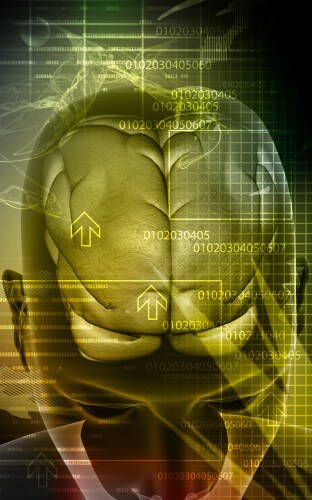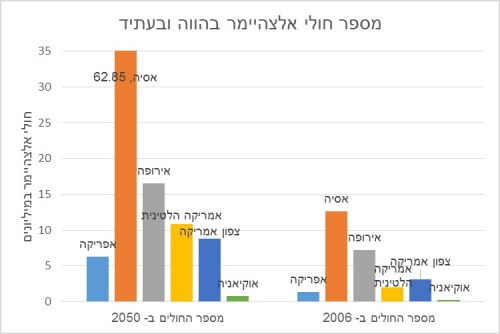Senior officials at DARPA decided to invest in a prosthesis for the human brain in order to relieve patients of diseases that affect the nervous system, mainly Alzheimer's

Today in the morning I accidentally called a distant friend of mine. I spoke to her briefly, and after a short minute of conversation we parted as friends.
A few minutes later, my phone rang. That friend decided to come back to me. I recognized the number immediately, and chose not to answer.
Throughout the rest of the day, the same friend called me no less than 79 times. On average, one call every eight minutes. She didn't do it with bad intentions, or because she decided to nag me and not give up.
She just didn't remember, every time, that she tried to call me already last time.
That friend suffers from dementia - insanity - in an advanced stage. That is, her ability to function in daily life was impaired due to deficits in memory and other cognitive skills. Two strokes in her brain almost a decade ago caused her to lose the ability to form new memories. She lives in a world of present and past, reacts every minute to the things that are said to her and forgets them the next minute. Even if I talked to her on the phone, she wouldn't remember it. Even if I told her how much I love and appreciate her, she wouldn't remember. She lost herself, deep in the recesses of her mind, and lost all her friends, acquaintances and lovers in the process. But she is not alone.
My friend shares the fate of millions of people who suffer from dementia and memory loss. There are different types of dementia, but the most common of all is that caused by Alzheimer's disease, which affects 26.6 million people worldwide (as of 2006). This number is expected to increase to 106.2 million patients, or 1 for every 85 people in 2050, due to the aging of the population. If you plan to still be alive in thirty-five years, these data are fate for you: this will be the society in which you will exist. Such that, if a solution to the disease is not found, every family living in a multi-storey building will find themselves in close proximity to an Alzheimer's patient or ten.

The clear meaning is that it is necessary to take action and find treatment for the madness. This is where DARPA, the agency for advanced security research in the United States, enters the picture for the first time. This agency is designed to fund research with a big and sky-high vision, and relatively low chances of success (or at least receiving funding from other sources). DARPA funded the first studies that led to the creation of the Internet, the technology behind Google's street mapping and the artificial intelligence behind Apple's SIRI, the satellite navigation system (GPS), and many others. In short, Darfa helps change the world behind the scenes, through research whose full value is often only discovered a few decades after the original investment. Now Darfa has decided to invest part of the hundred million dollars of Obama's 'Brain Initiative' in an attempt to create a 'memory prosthesis' that can help people re-formulate their memories.
DRAP is not only concerned about the large number of Alzheimer's patients in the world, but also (and perhaps mainly) about the existence of 270,000 American soldiers who returned from the wars in Iraq and Afghanistan suffering from memory impairment. As of today, no suitable treatments based on drugs or psychotherapy alone have been found for this type of injury, so Darfa executives decided to invest in a prosthesis for the human brain. I repeat: not in mice, not in rats, not in monkeys. Brain prosthesis in humans.
The studies on the way
Two research groups won the tender to carry out the project, and they are approaching it from two different directions. The first group, led by Prof. Michael Kahane from the University of Pennsylvania, will initially focus on identifying the biological signals in the brain that indicate the creation of new memories and 'retrieving' old memories from the depths of the brain into awareness. To do this, Kahane intends to examine epilepsy patients who have already had electrodes implanted in their brains, so it is possible to read at a high level what is happening between the walls of their skulls. By tracing the processes of creating and storing memories in the brain, Kahana hopes to understand which areas of the brain contain the relevant memories, and to stimulate them when necessary. He wants, in fact, to understand part of the language in which the memories are encoded - and call them in their language to rescue them from the depths of oblivion.
According to the report in IEEE Spectrum, Kahane hopes that within four years he will be able to create a system that can be implanted in the human brain and improves memory by monitoring the creation of memories and helping the brain to evoke them at the right time. He intends to demonstrate the system in epilepsy or Parkinson's patients, in whose brains electrodes are already implanted. If successful, the system will also be tested on soldiers who returned from the battlefield with severe brain injuries, and eventually - also on Alzheimer's patients.
The second group chose a similar path to achieve the goal, but intends to concentrate most of its efforts in the entorhinal cortex area, which mediates between the hippocampus (which creates new long-term memories in the brain) and the forebrain in humans. In my book "The Guide to the Future" I already wrote about the hippocampus as the 'bottleneck' through which much information coming to us from the senses and brain activity must pass. Only the little information that manages to pass through the bottleneck, manages to become a long-term memory, which settles in our minds for many years. The head of the second group, Yitzhak Fried, showed already in 2012 that he is able to improve the creation of long-term memories in seven epilepsy patients by activating electrodes in the entorhinal cortex area. Will he be able to do this also in soldiers who have returned from the service with a traumatic brain injury, or in Alzheimer's patients? Apparently, there is no reason not to.
The location of the hippocampus - the 'organ of long-term memory' in the brain. Source: Wikipedia
The location of the hippocampus - the 'organ of long-term memory' in the brain. Source: Wikipedia
Don't replace the brain with a computer (yet)
When I wrote "apparently, there is no reason not to", I did so with the full intention of equating the sentence with a tone of doubt. The human brain is the most complex machine known to… well, the human mind. An experiment that was successful in seven epilepsy patients may not be successful in other patients or victims. And Kahana's vision to understand language and the places where memories are written in the brain is almost megalomaniac in nature. Enormous computing power is required to carry out the task, and Kahane himself is well aware of this.
"We need to perform analyzes that used to take a personal computer for several hours, and summarize them into an algorithm of ten thousandths of a second." He admits in an interview with IEEE Spectrum. Will sufficiently advanced computational components exist in four years, when the project ends? We will have to wait and see.
Let's put things in perspective: I personally wish for the success of the researchers, but I am satisfied if we see functional prostheses reaching the general patient public in the next decade. I may be too pessimistic, but we must recognize that the brain is an enigma that is still far from our understanding, and breakthroughs in the field will not be achieved easily. And if that's not enough, the only way to directly affect individual nerve cells in this gray organ is to implant electrodes deep inside it, in complex surgeries that often result in a severe reaction from the immune system. This is not a simple, pleasant or safe procedure, and many would prefer to give it up... but only if they remember to do so.
Stimulation in the depths of the brain using implanted electrodes. Source: Wikipedia.
Stimulation in the depths of the brain using implanted electrodes. Source: Wikipedia.
Summary
It is gratifying to see the faith of DARPA and the United States government in our ability to develop a brain prosthesis in the future. The fact that the government invests in the area of money, indicates that the seniors up there truly believe that we will be able to interface with the human brain and improve its natural abilities or those that have been damaged. But the fact that the research funding goes through DARPA also implies that those senior officials do not expect that success, if any, will come in the coming years. Darfa invests in long-term research, whose consequences for society can be seen after twenty or thirty years - and then they usually skyrocket beyond anything that was expected in the past.
I believe this will also be the future of cerebral prostheses. There is still a long way to go before every delusional patient will be awarded a prosthesis that will regulate his thought process, but every long journey consists of a large number of small steps, which are centered on a path that is drawn in advance for the traveler. Darfa and the US government have now marked the path along which it will be walked in the coming decades, into the unknown future of the brain, memory and consciousness.

4 תגובות
By the way, in the link I gave, he talks about a difference of 1%, but this single percentage in the genome actually means that our brain is 3 times larger than a chimpanzee's brain... so it's actually a 300% change, and not a percentage as he presents it.
Just wondering, what would happen if the cerebral prosthesis was the cerebral cortex of a deceased person who donated his organs? (meaning not an electronic prosthesis, but a biological one)
Doctors already know how to transplant different tissues from donors into another person's body, so what will happen if they take a donor's cerebral cortex and try to combine it over the cerebral cortex of a person who is ready to receive the transplant? Will the two cerebral cortices merge together and begin to function as one large cerebral cortex?
Here is something interesting along these lines:
https://www.youtube.com/watch?v=uUmfw_lJO0s
It's interesting that your friend doesn't remember that she already tried to call you, but she does remember that she should call you. I mean something there does work properly.
Let them start experiments with the autoantisemitic capos in Israel and the world.